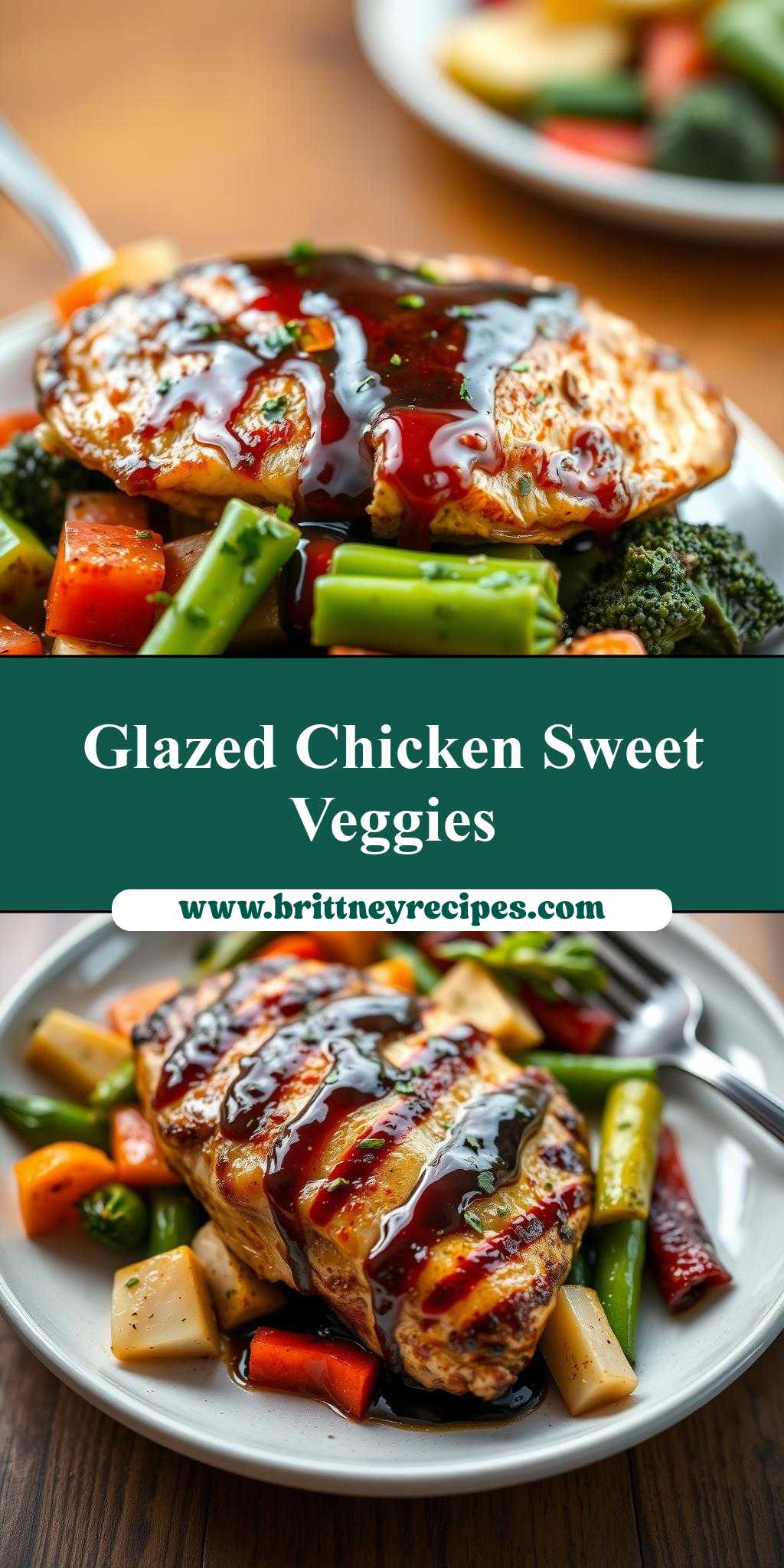What makes a weeknight dinner truly unforgettable? A sweet and tangy balsamic glaze, of course, paired with juicy chicken and roasted veggies for a quick and easy homemade meal. Try roasting with olive oil for a family favorite recipe. Save this idea
Balsamic Glazed Chicken and Veggies
Introduction
Imagine a dish that’s not only a feast for the eyes but also a symphony of flavors on your palate, all achieved with everyday ingredients and minimal fuss. The Balsamic Glazed Chicken and Veggies recipe is exactly that – a perfect blend of ease, flavor, and creativity. This recipe is designed to impress, whether you’re a busy professional looking for a quick yet satisfying meal or an avid cook seeking to elevate your culinary skills. With its rich balsamic glaze, tender chicken, and vibrant vegetables, this dish is sure to become a staple in your kitchen.
Why This Works
- Flavor balance and ingredient accessibility: The combination of balsamic vinegar, olive oil, garlic, and herbs creates a deep, well-rounded flavor profile that complements the chicken and vegetables perfectly. Moreover, these ingredients are readily available in most supermarkets, making this dish highly accessible.
- Ease of preparation: The recipe involves simple steps that require minimal cooking skills, making it perfect for beginners and experienced cooks alike. The prep time is short, and the cooking process is straightforward, allowing you to have a delicious meal on the table in no time.
- Impressive results with minimal effort: Despite its simplicity, the Balsamic Glazed Chicken and Veggies presents beautifully, with the glazed chicken and colorful vegetables making for a visually appealing dish. This makes it ideal for special occasions or when you want to impress your guests without spending hours in the kitchen.
Key Ingredients
The core of this recipe lies in its ingredients, each playing a crucial role in the overall flavor and texture of the dish. You’ll need:
– 2 boneless, skinless chicken breasts: These provide the protein base of the dish. You can substitute them with chicken thighs if you prefer a juicier texture.
– 1 large bell pepper, sliced: Bell peppers add a crunchy texture and a pop of color. Any color bell pepper works, but red or yellow adds a sweeter flavor.
– 1 large onion, sliced: Onions bring a depth of flavor and can be substituted with shallots for a sweeter, milder taste.
– 2 cloves of garlic, minced: Garlic is essential for its aromatic flavor. You can adjust the amount to your taste.
– 1/4 cup of balsamic vinegar: This is the key to the glaze, providing a rich, tangy flavor. You can use a high-quality store-bought balsamic vinegar or make your own reduction.
– 2 tbsp olive oil: Used for sautéing, olive oil adds a smooth, fruity flavor.
– Salt and pepper, to taste: These seasonings enhance the natural flavors of the ingredients.
– Fresh parsley, chopped (optional): Parsley adds a fresh, herbaceous note and a bit of color for garnish.
For practical substitutions, consider using different colored bell peppers for varying sweetness levels, or swapping chicken breasts with thighs for a different texture. If balsamic vinegar is not available, a mixture of red wine vinegar and honey can provide a similar sweet and sour glaze.
Instructions
- Step 1: Begin by preparing your ingredients. Chop the bell pepper and onion into slices, mince the garlic, and season the chicken breasts with salt and pepper.
- Step 2: Heat the olive oil in a large skillet over medium-high heat. Add the chicken breasts and cook until they’re browned on both sides and cooked through, about 5-6 minutes per side. Remove the chicken from the skillet and set it aside.
- Step 3: In the same skillet, add the sliced onions and bell peppers. Cook until they’re tender and lightly caramelized, stirring occasionally. This should take about 10 minutes. Add the minced garlic and cook for an additional minute, stirring constantly to prevent burning.
- Step 4: While the vegetables are cooking, prepare the balsamic glaze. In a small saucepan, bring the balsamic vinegar to a boil over medium heat. Reduce the heat to low and simmer until the vinegar has thickened into a glaze, stirring occasionally. This process should take about 10-15 minutes, depending on the vinegar’s initial consistency.
- Step 5: To finish the dish, brush the balsamic glaze over the cooked chicken breasts. Serve the chicken on top of the sautéed vegetables, garnished with chopped parsley if desired.
Handy Tips
- For a crisper glaze, cook the balsamic vinegar reduction until it’s almost syrupy. Be cautious not to overcook, as it can become too thick and sticky.
- Use any combination of your favorite vegetables. Zucchini, mushrooms, and carrots work well in this recipe.
- Avoid overcooking the chicken and vegetables. The chicken should be cooked through but still juicy, and the vegetables should retain some crunch.
Heat Control
Heat control is crucial in this recipe, especially when cooking the chicken and reducing the balsamic vinegar. For the chicken, medium-high heat is ideal for achieving a nice brown on the outside while keeping the inside juicy. When reducing the balsamic vinegar, start with medium heat and adjust to low once it begins to simmer, to prevent it from burning or becoming too thick too quickly. The ideal temperature for cooking the chicken is between 165°F and 170°F. For the vegetables, cook them over medium heat, stirring occasionally, until they’re tender but still crisp.
Crunch Factor
The crunch factor in this dish comes from the vegetables. To achieve the perfect crunch, don’t overcook the bell peppers and onions. They should be tender but still retain some of their natural crispness. If using other vegetables like carrots or zucchini, adjust the cooking time based on their texture and density. A light sauté is usually enough to bring out their natural sweetness without making them too soft.
Pro Kitchen Tricks
- Marinate the chicken in a mixture of olive oil, garlic, and herbs before cooking for extra flavor.
- Use a cast-iron skillet for cooking, as it retains heat well and can achieve a nice sear on the chicken.
- For easier cleanup, line your skillet with parchment paper before cooking the vegetables.
Storage Tips
- Leftovers can be stored in an airtight container in the refrigerator for up to 3 days. Reheat gently in the microwave or oven until warmed through.
- Freezing is not recommended for this dish, as the texture of the vegetables and the glaze may suffer. However, you can freeze the cooked chicken and reheat it with freshly cooked vegetables and glaze.
- Use glass containers for storing, as they preserve flavors and textures better than plastic.
Gift Packaging Ideas
If you’re considering gifting this dish, perhaps for a potluck or as a meal for a friend, presentation is key. Transfer the cooked chicken and vegetables to a decorative ceramic dish or a wooden platter. Drizzle the balsamic glaze over the top in a decorative pattern. You can wrap the dish in clear plastic wrap or aluminum foil and tie a ribbon around it for a more personalized touch. Include a side of crusty bread or a baguette for a complete gift.
Flavor Variations
- Different spices: Add a pinch of red pepper flakes for a spicy kick, or use Italian seasoning for a more herbaceous flavor.
- Creative toppings: Top the dish with crumbled feta cheese, chopped fresh basil, or toasted pine nuts for added texture and flavor.
- Ingredient swaps: Substitute chicken with shrimp or tofu for a vegetarian option. Use different types of vinegar, like apple cider vinegar, for a unique flavor profile.
Troubleshooting
- Texture problems: If the vegetables become too soft, it may be due to overcooking. Adjust the cooking time based on the vegetable’s density and your desired level of crunch.
- Ingredient replacements: If you’re missing an ingredient, refer to the substitutions mentioned earlier in the recipe. For example, you can use red wine vinegar mixed with a bit of honey as a substitute for balsamic vinegar.
- Over/undercooking signs: Check the chicken’s internal temperature to ensure it’s cooked through. For the vegetables, taste them periodically to avoid overcooking.
FAQs
- Can I freeze it? While freezing is not the best option for this dish due to texture changes, you can freeze the cooked chicken. Reheat it with freshly cooked vegetables and glaze for the best results.
- Is it gluten-free? Yes, this recipe is naturally gluten-free, making it suitable for individuals with gluten intolerance or sensitivity.
- Can I double the recipe? Absolutely, this recipe can be easily doubled or tripled for larger groups. Just ensure you have a large enough skillet to cook the chicken and vegetables in batches if necessary, to prevent overcrowding.
Conclusion
In conclusion, the Balsamic Glazed Chicken and Veggies recipe offers a delicious, easy, and impressive meal solution for any occasion. With its balanced flavors, accessible ingredients, and straightforward instructions, it’s a dish that everyone can enjoy. Feel free to experiment with the recipe, adding your own favorite vegetables or spices to make it truly yours. Share your creations and adaptations with friends and family, and don’t hesitate to reach out if you have any questions or need further substitutions or variations. Happy cooking, and I look forward to hearing about your culinary adventures with this recipe!

